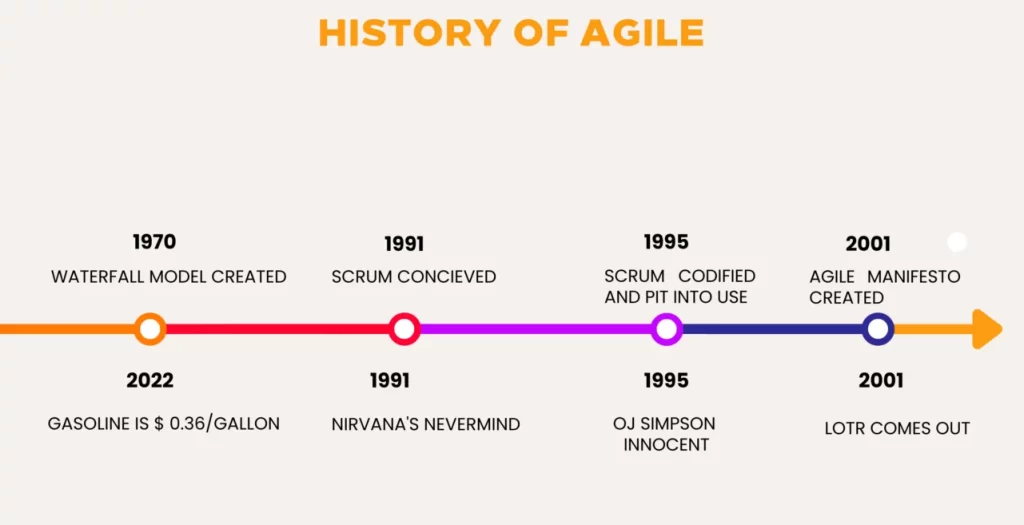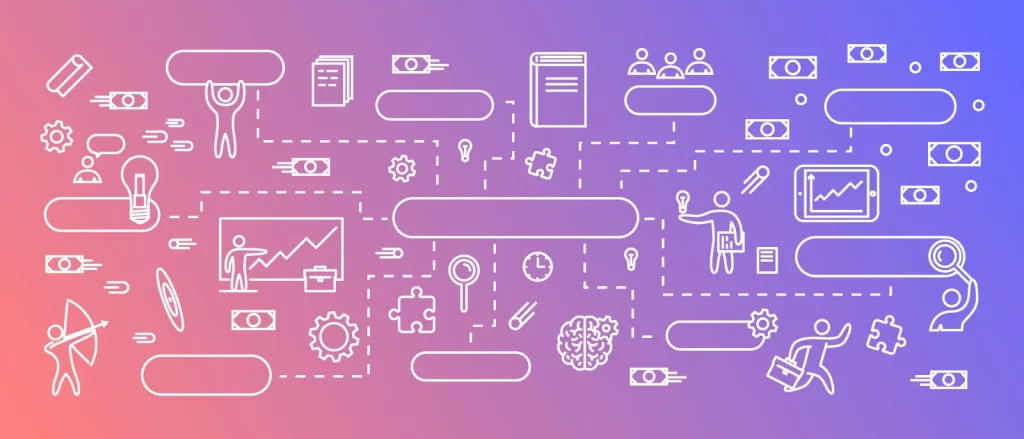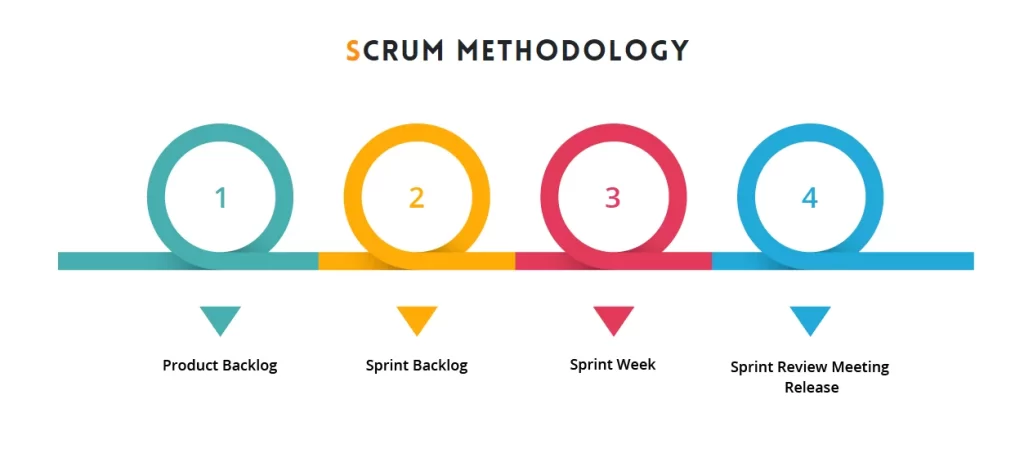
© 2024 | All Right Revered.

Senior Marketing Associate
Passionate about marketing with an affinity to learn about the ever-developing IT sector.

Agile methodology is most commonly used in software development projects, particularly those that are complex and require frequent changes or updates. This is because the agile methodology is well-suited to software development, which often involves a high degree of uncertainty, unpredictability, and evolving customer needs.
Before we delve into the realm of Agile methodology, exploring its various benefits, different types, frameworks, and implementation, let us take a look at what agile methodology directly constitutes.

Back when software development was essentially dominated by traditional methodologies such as the Waterfall model, agile methodologies started to lay its roots in the 1990s. Due to the limitation of dominant methodologies, such as the waterfall model, in struggling to meet and deliver high-quality software products in a constantly and rapidly changing environment, led to the emergence of agile methodologies.
Moving on to 2001, a group of software developers create the Agile Manifesto which lay out a set of principles for software development that prioritized individuals and interactions, working software, customer collaboration, and response to change over processes and tools. This in turn marked the beginning of the agile movement, which has since evolved into a set of methodologies such as Scrum, Kanban, and Lean (to name a few).
Since its inception, agile methodology has gone through several significant evolutionary changes and refinement, with new emerging techniques and practices to help improve the delivery of software products. As of today, Agile Methodology is widely used across industries and has become a standard practice in software development, helping teams to deliver high-quality software products in a flexible and adaptive manner.
Agile methodology can be defined as an interactive and collaborative approach to project management that focuses on delivering high-quality, functional software products in a flexible and adaptable manner. It is based on the Agile Manifesto. This Manifesto essentially values individuals and interactions, working software, customer collaboration, and response to change over processes and tools.
Within agile methodology, the development is fragmented into small, manageable iterations, called sprints, each of which typically lasts anywhere between 1 to 4 weeks. During each sprint, the development team works closely with the product owner to define, prioritize, and execute a set of user stories or features that will be delivered at the end of the sprint.
What this does, is encourage frequent communication, feedback, and collaboration between team members and the specific stakeholders, helping to ensure that the end product meets the targeted and documented needs and requirements. The iterative nature of agile development allows for continuous improvement, review, and adjustments throughout the project, which enables teams to adapt to changing requirements, customer feedback, and market conditions.
While agile methodology is popular in software development projects, it has also gained prominence in marketing, education, health care, finance, and lastly large-scale government initiatives. Some popular agile methodologies include Scrum, Kanban, and Lean, all of which we will take a look at later on in this article.

It allows teams to adapt quickly to changing requirements and market conditions. The iterative approach to development enables teams to break down the project into smaller, more manageable chunks, and make adjustments as needed. This ensures that the end product meets the customer’s evolving needs and requirements.
Agile methodology encourages frequent communication and collaboration between team members and stakeholders. This helps to ensure that everyone is on the same page and working towards the same goal. By working together, teams can identify and resolve issues more quickly, resulting in higher-quality software.
Agile methodology is designed to enable teams to deliver functional, high-quality software products in a shorter timeframe. The iterative nature of agile development means that features can be developed and delivered in small, manageable iterations, reducing the time required to develop and test the software.
By prioritizing customer collaboration and feedback, agile methodology ensures that the end product meets the customer’s needs and requirements. This results in a higher level of customer satisfaction, as the customer is actively involved in the development process and has a greater degree of input into the final product.
The main idea is to blur the image for Step #2 but you can also add some additional modifying by playing around with elements such as the brightness, vignette, and Saturation.
Step 2: Add your Image
And that’s it! You are now ready to go!
Both the Agile and waterfall methodologies aim to deliver products through a process that meets customer requirements. However, they differ in their specific methods, processes, and area of focus.
Waterfall methodology can best be described as a traditional, linear approach to project management. It involves breaking down the project into sequential phases with each phase building on the previous one. Each phase must be completed before the next one can begin. Consequently, this means there is little room for change or iteration during the development process. In other words, change is expensive and difficult to bring about once a phase has been completed. Proceeding otherwise can risk costly delays and rework.
Agile methodology is an interactive and collaborative approach to project management. It involves breaking own development into small, manageable iterations called sprints, each of which lasts between one to four weeks. During each sprint, development team members work closely with the product owner in order to define, prioritize, and execute a set of user stories or features that will be delivered at the end of that sprint.
Dealing with change, in agile methodology, is embraced and incorporated into the development process. Agile teams prioritize customer collaboration and are able to respond quickly to changing requirements, customer feedback, and market conditions. The interactive nature of agile development allows for continuous improvement and adjustment throughout the project, ultimately enabling teams to adapt to changing circumstances.
To summarize, waterfall methodology provides a clear and structured approach to project management, it is inflexible and difficult to adapt to changing requirements. Agile methodology, on the other hand, is more flexible and responsive but requires more collaboration and communication between team members and stakeholders.
Over time, agile methodology has gained widespread popularity in recent years due to its flexibility, adaptability, and ability to deliver high-quality software products quickly. There are several frameworks available for agile software development, each with its own unique set of practices, principles, and benefits. In this section of the article, we will explore some of the most popular agile frameworks used by organizations worldwide.

Scrum is the most popular framework for agile software development. It is based on the principles of transparency, inspection, and adaptation. It is designed to help empower teams to deliver high-quality software products quickly and efficiently by focusing on collaboration, communication, and continuous improvement. Let us take a look at the individual roles and steps that are involved in the Scrum framework.
Scrum involves three primary roles – the Product Owner, the Scrum Master, and the Development Team.
The Product Owner holds the responsibility for defining the product backlog, prioritizing the assigned work, and ensuring that the team is delivering the expected value to the customer.
The Scrum Master is responsible for facilitating the Scrum events. He does so by removing any hindrances or impediments that may prevent the team from achieving its goals, and in turn, consequently promotes a culture of continuous improvement.
The Development Team holds the responsibility for delivering the product increment at the end of each sprint.
This constitutes the first step in Scrum. The team meets to plan the work for the upcoming sprint. The Product Owner defines the objects for the sprint after which the team collaborates to determine the way to achieve these objects. Following this, the team creates a sprint backlog, which is a list of items that they plan to deliver during the sprint.
Daily Scrum refers to a brief meeting on a daily basis. Here, the team meets to discuss recent progress, share updates, and identify hindrances preventing them from achieving the forecasted goals.
The meeting is restricted to 15 minutes and each team member answers primarily the three following questions:
In this phase, the team works on the spring backlog items in order to deliver the product increment. The team works together, employing frequent communication and feedback, to ensure that they are making progress in the direction of the sprint goal.
Backlog Refinement refers to an ongoing process of reprioritizing and refinement with the product backlog in order to ensure that it is up to date and reflects the current priorities of the business. The Product Owner works with the team to ensure that the backlog items are well-defined and that the team has a clear understand of what tasks are needed to be achieved and what expectations are to be met.
Kanban is a popular framework for agile software development that encourages teams to identify and eliminate any bottlenecks in the workflow. Unlike other agile frameworks, Kanban does not prescribe any specific roles, events, or artifacts, and is therefore more flexible and adaptable.
It is particularly useful for teams that work on a variety of tasks and projects simultaneously, as it allows them to prioritize work based on customer needs and business objectives. Overall, Kanban is an effective framework for agile software development that can help teams improve their productivity, efficiency, and customer satisfaction.
Lean is based on the principles of lean manufacturing. It emphasizes on maximizing customer value while, at the same time, minimizing waste and aims to deliver high-quality software products in a quick and efficient manner. Lean involves identifying and removing activities that do not add value to the customer. It also emphasizes continuous improvement and encourages teams to work together to identify and address any inefficiencies in the workflow.
Lean has served to be extremely useful for teams working on large and complex projects. It allows them to break down projects in smaller, manageable pieces and ultimately deliver value to the end-customer incrementally. To summarize, Lean is an effective framework for agile software development that can help teams improve their productivity, efficiency, and customer satisfaction.
Extreme Programming (XP) specializes in improving software quality and responsiveness. It operates on continuous integration, test-driven development, pair programming, and refactoring which collectively reduces the risk of defects and improves the maintainability of the codebase. XP also prioritizes customer involvement and feedback, with the aim of delivering software products to meet the customer’s needs and expectations.
XP holds particular value for teams that work on complex and rapidly changing and evolving projects. This is due to the fact that it allows them to respond quickly to changes in requirements or market conditions. To summarize, XP is an effective framework for agile software development that is capable of helping teams improve their software quality, responsiveness, and customer satisfaction.
While there are numerous benefits that the Agile methodology brings to the team, it is not without its fair share of challenges and setbacks.
One common challenge is resistance to change. This is especially prevalent in organizations that have a long-standing history of using traditional methodologies. To overcome this challenge, it is important to involve all the various stakeholders in the process and communicate the benefits of agile methodology.
This can include various elements, such as holding informational sessions and training programs to help educate and bring awareness to the team members on the principles and practices of the agile methodology.
The second most common challenge revolves around the lack of clarity around roles and responsibilities. This can contribute to confusion and inefficiencies, especially when team members are not sure of what is expected from them. In order to combat this challenge, there is a need to effectively define roles and responsibilities, establish processes for collaboration and communication, and provide ongoing training and support to ensure that all team members fully understand their roles and responsibilities and are empowered to implement themselves according to the Agile methodology.
Another challenge lies in the difficulty associated with managing dependencies between teams. While Agile methodology emphasizes cross-functional teams working in close collaboration, it can also create a new challenge when there are dependencies associated between different teams. In order to overcome this challenge, it is crucial to establish clear communication channels between teams and ensure that all teams involved are aligned on their priorities and consequent timelines. This involves regular meetings and status updates to keep everyone informed and helps identify potential roadblocks or issues as well.
The key to overcoming challenges associated with Agile methodology is to approach it as a continuous improvement process. This refers to having regular retrospectives and feedback sessions to streamline the approach of all team members involved in the project. Lastly, in cases where required, enlisting an experienced Agile coach or mentor can help provide valuable guidance and support through the transition to an Agile framework.
Overall, the key to overcoming these challenges is to approach Agile implementation as a continuous improvement process. This involves regular retrospectives and feedback sessions to identify areas for improvement and make necessary adjustments to the Agile processes. Additionally, enlisting the support of an experienced Agile coach or mentor can provide valuable guidance and support throughout the transition.
Share the details of your project – like scope, timeframe, or business challenges. Our team will carefully review them and get back to you with the next steps!

© 2024 | All Right Revered.
This guide is your roadmap to success! We’ll walk you, step-by-step, through the process of transforming your vision into a project with a clear purpose, target audience, and winning features.